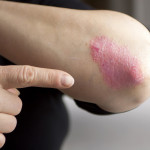 Psoriasis is a common skin condition that causes skin cells to grow too quickly and build up, leaving thick, red, silvery, or scaly patches (plaques) on the surface of the skin. Psoriasis is not contagious so you can’t get it from touching someone who has it.
Psoriasis is a common skin condition that causes skin cells to grow too quickly and build up, leaving thick, red, silvery, or scaly patches (plaques) on the surface of the skin. Psoriasis is not contagious so you can’t get it from touching someone who has it.
What are the symptoms of psoriasis?
- Skin patches with raised edges that are red with silvery-white scales (called plaques)
- Rashes on genitals, scalp, or in skin folds (such as the folds you have on your knees and elbows)
- Itching
- Pain
- Dry, cracked skin that may bleed
- Thickened, pitted, or discolored nails
- Swollen, painful joints (psoriatic arthritis)
For most people, psoriasis patches vary in size. They can range from small spots with dandruff-like flakes to wide patches that cover large areas of skin. Mild psoriasis can be annoying, but severe cases can be painful, cause scarring, and sometimes limit a person’s mobility. Flares (when psoriasis gets worse) occur in cycles, with symptoms that last for weeks to months and may then lessen for a period of time before coming back.
What causes psoriasis?
Medical researchers believe that psoriasis is a chronic autoimmune skin disease; however, it has also been linked to genetic and environmental factors. Psoriasis runs in families.
Immune: The immune system is made up of cells that help the body fight infection. With psoriasis, the immune system becomes overactive causing these immune cells to move to the top layer of skin (the epidermis) and act as if they are healing a wound. They stimulate skin cells to grow too quickly, and this causes the thick, scaly build-up seen in psoriasis plaques. During this process, these hyperactive immune cells cause your blood cells to dilate or widen (making the patches very red) and more immune cells move towards the surface of the skin. The result is a cycle in which new cells are made too quickly, in days instead of weeks. The dead skin can’t fall off fast enough, which leads to plaque formation. This process only stops when treatment interrupts the cycle.
Genetic: Studies have shown that many people with psoriasis have a family member with it. There are some genes that may make a person more likely to develop it, but right now there is no genetic test to tell whether someone will develop psoriasis.
There are certain things that can trigger a psoriasis flare-up (when the psoriasis becomes worse), such as:
- Certain infections (such as strep throat)
- Certain medicines (for high blood pressure or medications that treat a disease called malaria.)
- Stress
- Smoking
- Cold, dry weather
- Alcohol
- Injury to skin (bug bites/cuts/burns, etc.)
What are the different types of psoriasis?
There are several types of psoriasis. Each type affects different parts of the body.
- Plaque psoriasis is the most common form with plaques covered in silvery scales. The plaques can occur anywhere on the body, including the soft tissue of your mouth. The most common area of chronic plaque psoriasis on the body is a person’s scalp and/or lower back.
- Nail psoriasis causes pitting, abnormal nail growth, and discoloration. The nails may actually become loose and separate from the nail bed. Both guys and girls can have nail psoriasis; however, it is more commonly seen in boys.
- Facial psoriasis most often affects children rather than adults and can cause redness and scaly patches/plaques around the eyebrow area, skin folds, and around the mouth.
- Scalp psoriasis results in itchy plaques on the scalp with silvery-white scales. Some people notice flakes in their hair or on their shoulders, especially after scratching their scalp.
- Guttate psoriasis causes small, thin plaques of round sores covered with a fine scale. It can occur all over the body and is usually triggered by infections such as strep throat.
- Inverse psoriasis generally causes smooth patches of inflamed skin in the armpits, groin, under the breasts, and the genitals. It occurs commonly in overweight people and is triggered by friction and sweating.
- Pustular psoriasis is uncommon and can be a very serious type of psoriasis. It can involve small areas of the body such as the hands and feet, or it may cover a large part of the body. In general, the skin gets red and tender and then pus filled blisters develop. These blisters tend to dry up within 1-2 days, but flares can occur every few days or weeks. Sometimes people experience chills, fevers, fatigue, or intense itching with these flares.
- Erythrodermic psoriasis is rare, and can be serious. Along with other problems, it causes an itchy, burning, red peeling sunburn-like rash that can involve the entire body. Anyone who has an erythrodermic psoriasis flare-up should see a health care provider right away.
Is there a test for psoriasis?
There’s no test specifically for psoriasis, but your health care provider or dermatologist (skin specialist) will usually be able to tell if you have it by looking at your skin and asking you questions about family history and recent illnesses. Rarely, your dermatologist may need to test a ample of skin (biopsy) to confirm the diagnosis.
How common is psoriasis?
About 7.5 million people who live in the United States have been diagnosed with psoriasis and it affects both women and men equally. It is more common among adults but it often begins during childhood.
What can I do to take care of my psoriasis?
There isn’t a cure for psoriasis, but there are good ways to keep the symptoms controlled. In general, taking care of your skin helps a lot:
- Prevent sunburn
- Be careful not to irritate your skin (avoid bug bites, etc.)
- Avoid scratching your skin
- Moisturize your skin every day
- Eat healthy food
- Maintain a healthy weight
- Talk to your primary care provider or dermatologist (skin specialist)
There are also many types of treatment available. Based on your symptoms, your health care provider or dermatologist (skin specialist) will help you choose the right treatment or combination of treatments. All psoriasis treatments work by slowing down the growth of new skin, decreasing the immune response that causes the plaques, or both.
What are some of the treatments for psoriasis?
Topical treatments are medicines that are applied to the skin, and are usually the first method of treatment for people with psoriasis. They slow down the growth of cells and help old skin shed. Some common topical treatments include moisturizers, vitamin D creams, prescription corticosteroids, and shampoos with salicylic acid or coal tar.
Light therapy (also called phototherapy) involves exposing the skin to ultraviolet (UV) light. It works by slowing skin growth and reducing inflammation.
Different types of light therapy include:
- Sunlight: Your health care provider may recommend going outside for short periods of time to expose your skin to the sun’s rays.
- UVB light therapy: This type of treatment is usually done in a medical office, and involves exposing the skin to artificial UVB rays 2-3 times a week. As skin improves, treatment times become less frequent.
- PUVA light therapy: This type of treatment is usually done in a medical office, and involves exposing the skin to UVA rays while a person is taking a medicine called psoralen.
Other things to know about light therapy:
- Light therapy is not painful
- With UVB therapy, psoriasis may get worse before it gets better
- Before you start light therapy, make sure to tell your health care provider/dermatologist about any other medicines you’re taking, as some of them can cause your skin to be more sensitive to light
- Your PCP or dermatologist may recommend that you limit or avoid spending time in the sun while you’re undergoing light therapy
Remember: Too much sunlight can make psoriasis worse, so it’s important to follow your health care provider’s instructions. In addition, the American Academy of Dermatology, the FDA and the CDC are against tanning beds. Indoor tanning is not the same as light therapy, and is not considered an effective treatment for psoriasis.
Systemic medications are medicines that work throughout the whole body to affect cell growth and help decrease the body’s immune response. These types of medicines are usually taken by people whose psoriasis doesn’t get better with topical treatments such as ointments, creams, lotions, gels, or foam solutions and UV light therapy.
Biologic medications work by targeting specific parts of the body’s immune system to reduce the fast skin cell growth and inflammation. These types of medicines are usually taken by people with moderate to severe plaque psoriasis that hasn’t gotten better with other treatments.
How effective are psoriasis treatments?
The effectiveness of treatments varies depending on your symptoms. You may have to work with your health care provider to find the best treatment, or combination of treatments, for your psoriasis. No matter what treatment you use, the key is keeping up with the medicine on a regular basis. This may mean putting on a cream twice a day or taking a pill daily, even when you don’t have flare-ups. Some people find it helpful to put an alarm on their cell phone as a reminder. Just remember, psoriasis treatment works best when used regularly.
Am I likely to have other medical problems because I have psoriasis?
Some people who have psoriasis may have other health conditions that may or may not be associated with psoriasis. Tell your primary care provider if you have any other medical problems and if you are seeing other specialists (such as a dermatologist).
What if I’m embarrassed about the way my skin looks?
People with psoriasis may feel self-conscious or embarrassed, and/or sad or anxious about the way their skin looks or makes them feel. If you have psoriasis and it is affecting the quality of your life, tell your health care provider. He or she can recommend a therapist and/or may know of a support group where you can talk with others with similar skin issues.
Source: Read Full Article





